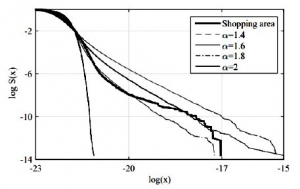What if the world of the Internet of Things wasn’t Gaussian?
Interference is constantly growing in wireless communications due to the increase of communicating objects. It comes in addition to the usual receiver noise. However, it does not have the same statistical properties which should significantly impact the design of the receiver. Realized with researchers from Aalborg, the first measurements of these interferences in the 868 MHz band highlight their non-Gaussian nature.
5G and beyond sees an ever-increasing density of connected things. As not all devices are coordinated, there are limited opportunities to mitigate interference. As such, it is crucial to characterize the interference in order to understand its impact on coding, waveform and receiver design. While a number of theoretical models have been developed, there is very little experimental validation. This work addresses this key gap in understanding by performing statistical analysis on recent measurements in the unlicensed 863 − 870 MHz band in different regions of Aalborg, Denmark (see Figure). In particular, the measurement data show that the distribution of the interference power is heavy tailed, confirming predictions from theoretical models.
1. Interference is the consequence of concurrent, at least partially, transmissions from different devices on the same channel observed by a given receiver. Dating back to Middleton (1977), stochastic geometry has played an important role in characterizing interference statistics. In this approach, interferers are located according to a homogeneous Poisson point process, and non-Gaussian interference distributions naturally arise. A significant result is that the tail behaviour of the distribution is dominated by the strongest interferer and sub-exponential distributions often arise.
2. This work presents the first confrontation of these theoretical results to experimental data. Received power measurements were performed at 5 distinct locations in Aalborg (Denmark) – downtown, business park, hospital, industrial area and residential area. Measurements were performed at street level by using a radio network scanner equipped with an omni-directional antenna for a period of 2 hours. The entire on-air RF activity in the 868 MHz ISM band (863-870 MHz) was recorded.
3. The measurement data obtained at the five different locations, confirm the hypothesis of the sub-exponential nature of the distribution of interference power. The presented graph shows the survival function of the data and from known distribution (exponential, denoted by a=2, and sub-exponential, denoted by a=1.4, 1.6 and 1.8). It clearly validates the heavy tailed nature of the interference in the context of Internet of Things (IoT) communications. Interference models are the key to designing efficient coding and decoding strategies as well as efficiently adapting channel access and the network topology. As such, the measurement data suggests that there is a need to reconsider the utility of Gaussian models in network design for the IoT.
Laurent Clavier, Troels Pedersen, Ignacio Larrad, Mads Lauridsen, and Malcolm Egan, Experimental Evidence for Heavy Tailed Interference in the IoT, IEEE COMMUNICATIONS
LETTERS 25 (2021), no. 3, 692-695.















